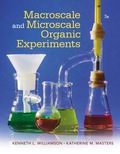
Which experimental method would you recommend for the preparation of 1-bromooctane and of t-butyl bromide?
Interpretation: The experimental method for the preparation of 1-bromooctane and t-butyl bromide needs to be explained.
Concept Introduction: Organic synthesis is a branch of chemical synthesis where the preparation of only organic compounds is studied. Compared to inorganic compounds, organic compounds are more complex. There are several methods for the preparation of an organic compound, but the best experimental method is the one that has fewer steps and gives more yield to the organic compound.
Explanation of Solution
Preparation of 1-bromooctane:
In organic synthesis, 1-bromooctane is an important intermediate. It is soluble in ether and ethanol. It is used for the synthesis of pesticides, surfactants, and organic dyes. There are the following steps involved in the preparation of 1-bromooctane:
- 250 mL of a three-necked flask is taken with a thermostat and stirring machine.
- In the same flask, n-octanol and sulfated zirconia-zincoxide are taken in the desired amount.
- After that hydrobromic acid (40 %) is added slowly to the mixture and it is then stirred well.
- Due to stirring, the temperature of the mixture increases.
- In the next step, a saturated sodium bicarbonate solution is added to the reaction mixture and it is cooled to room temperature.
- The resulting mixture is then separated and washed many times with deionized water until a neutral liquid is obtained.
- The 1-bromooctane produced can be tested by gas chromatography.
Preparation of t-butyl bromide:
The following steps are involved in the preparation of t-butyl bromide:
- In the first step of preparation, 1 mol of tert-butyl alcohol is reacted with 1.25 mol of HBr.
- The obtained mixture is then boiled which results in the distilled volatile tert-butyl bromide.
- The crude tert-butyl bromide obtained in step 2 is shaken with cold sulphuric acid (1/5th volume) in order to dissolve the ether formed as a by-product.
- In the next step, the product is washed with water and sodium bicarbonate to get it free from acid.
- It is washed again with water and dried over calcium chloride.
Want to see more full solutions like this?
Chapter 16 Solutions
EBK MACROSCALE AND MICROSCALE ORGANIC E
- Transmitance 3. Which one of the following compounds corresponds to this IR spectrum? Point out the absorption band(s) that helped you decide. OH H3C OH H₂C CH3 H3C CH3 H3C INFRARED SPECTRUM 0.8- 0.6 0.4- 0.2 3000 2000 1000 Wavenumber (cm-1) 4. Consider this compound: H3C On the structure above, label the different types of H's as A, B, C, etc. In table form, list the labeled signals, and for each one state the number of hydrogens, their shifts, and the splitting you would observe for these hydrogens in the ¹H NMR spectrum. Label # of hydrogens splitting Shift (2)arrow_forwardNonearrow_forwardDraw the Lewis structure of C2H4Oarrow_forward
- a) 5. Circle all acidic (and anticoplanar to the Leaving group) protons in the following molecules, Solve these elimination reactions, and identify the major and minor products where appropriate: 20 points + NaOCH3 Br (2 productarrow_forwardNonearrow_forwardDr. Mendel asked his BIOL 260 class what their height was and what their parent's heights were. He plotted that data in the graph below to determine if height was a heritable trait. A. Is height a heritable trait? If yes, what is the heritability value? (2 pts) B. If the phenotypic variation is 30, what is the variation due to additive alleles? (2 pts) Offspring Height (Inches) 75 67.5 60 52.5 y = 0.9264x + 4.8519 55 60 65 MidParent Height (Inches) 70 75 12pt v V Paragraph B IUA > AT2 v Varrow_forward
- Experiment: Each team will be provided with 5g of a mixture of acetanilide and salicylic acid. You will divide it into three 1.5 g portions in separate 125 mL Erlenmeyer flasks savıng some for melting point analysis. Dissolve the mixture in each flask in ~60mL of DI water by heating to boiling on a hotplate. Take the flasks off the hotplate once you have a clear solution and let them stand on the bench top for 5 mins and then allow them to cool as described below. Sample A-Let the first sample cool slowly to room temperature by letting it stand on your lab bench, with occasional stirring to promote crystallization. Sample B-Cool the second sample 1n a tap-water bath to 10-15 °C Sample C-Cool the third sample in an ice-bath to 0-2 °C Results: weight after recrystalization and melting point temp. A=0.624g,102-115° B=0.765g, 80-105° C=1.135g, 77-108 What is the percent yield of A,B, and C.arrow_forwardRel. Intensity Q 1. Which one of the following is true of the compound whose mass spectrum is shown here? Explain how you decided. 100 a) It contains chlorine. b) It contains bromine. c) It contains neither chlorine nor bromine. 80- 60- 40- 20- 0.0 0.0 TT 40 80 120 160 m/z 2. Using the Table of IR Absorptions how could you distinguish between these two compounds in the IR? What absorbance would one compound have that the other compound does not? HO CIarrow_forwardIllustrate reaction mechanisms of alkenes with water in the presence of H2SO4, detailing each step of the process. Please show steps of processing. Please do both, I will thumb up for sure #1 #3arrow_forward
 Macroscale and Microscale Organic ExperimentsChemistryISBN:9781305577190Author:Kenneth L. Williamson, Katherine M. MastersPublisher:Brooks Cole
Macroscale and Microscale Organic ExperimentsChemistryISBN:9781305577190Author:Kenneth L. Williamson, Katherine M. MastersPublisher:Brooks Cole Organic ChemistryChemistryISBN:9781305580350Author:William H. Brown, Brent L. Iverson, Eric Anslyn, Christopher S. FootePublisher:Cengage Learning
Organic ChemistryChemistryISBN:9781305580350Author:William H. Brown, Brent L. Iverson, Eric Anslyn, Christopher S. FootePublisher:Cengage Learning

